A Saxophone Stand That Fits in The Bell – But Will it Hold Up?
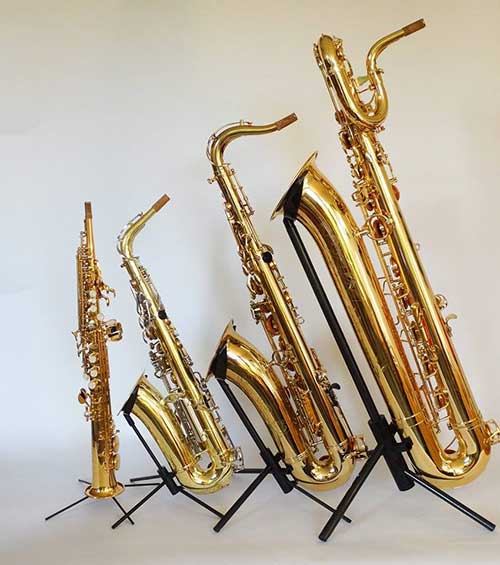
Introduction
The saxophone stand is probably one of the most overlooked accessories by saxophonists today (at least in my opinion). The saxophone stand, although scene as a simple piece equipment with the purpose of holding the saxophone, should not be overlooked. There are a few popular manufacturers such as Hercules, Hamilton, K&M, which have been manufacturing saxophone stands for quite some time.
Within the last few years, I have seen a few vendors start to experiment with materials such as carbon fiber to manufacture cases, reeds, mouthpieces and even saxophone necks. At this year’s NAMM show, Gijs van Leeuwen (Owner of WoodWindDesign) introduced his carbon fiber saxophone stand for soprano, alto, tenor and baritone (low A & Bb). Gijs was nice enough to send me a carbon fiber stand for soprano, alto, tenor and baritone saxophone to try out. I will be providing a product overview for the WoodWindDesign Carbon Fiber Saxophone Stands as well as my overall thoughts and feedback.
Product Overview
The Carbon Fiber saxophone stands offered by WoodWindDesign’s are very light weight stands (much lighter than traditional saxophone stands) that can be easily broken down and transported inside the bell of the saxophone when traveling. Although these carbon fiber saxophone stands are extremely light, the carbon fiber material and design make these stands incredibly stable.
Two features to note on each stand is the saxophone pegs and bell holder. The saxophone pegs each has a rubber foot to absorb any shock or movement that could occur from someone accidentally knocking into the stand for example. The bell holder design for the alto, tenor and baritone saxophone securely holds the saxophone in place at various angles due to the length of the curve as well as the lined rubber. The lined rubber is a better option over traditional foam because there is a better grip on the instrument leading to further protection.
A popular feature with this stand is it can to be fully disassembled to fit in the bell of the saxophone as you put the horn back in the case while traveling to your next gig. There are five carbon tubes that each have a different diameter and actually fit into one another. The tubes and peg once dis-assembled fit into a cloth bag (provided with stand) that you place in the bell of your saxophone. The bell holder does not fit in the bell of your saxophone but instead fits over the bell. With each stand placed in the case, you will be surprised how light weight they are and in many cases, you do not even notice the extra weight.
Weight:
- Soprano: 50gr/1.8 oz
- Alto: 90 gr/3.2 oz
- Tenor: 190gr/6.7 oz
- Baritone: 500 gr/1.1 lbs
Gijs Product Demonstration
Review
I was excited when I received the WoodWindDesign carbon fiber saxophone stands for soprano, alto, tenor, and baritone. From my experience testing out various necks, reeds, and cases that have been manufactured with carbon fiber, I have overall been very impressed with this material.
Weight: These are by far some of the lightest (or the lightest) saxophone stands I have had the chance to test (especially baritone saxophone) to date. Compared to my Hercules, Hamilton, and On-Stage stands, all four (soprano, alto, tenor, baritone) of these stands combined weigh less than 2 pounds. Since all four stands are so light weight, they are very easy to carry from practice to practice or gig to gig.
Transportation: Many saxophone stands are able to be folded like a music stand for transportation. What I liked about the WoodWindDesign saxophone stands in comparison was each carbon fiber stand is able to be dissembled to the point which you can fit the stand inside the saxophone bell. The overall benefit is an easier way to transport your saxophone stand(s).
Protection: A light weight and easily transportable stand are important features of a great saxophone stand BUT the overall protection the stand provides your saxophone is by far the most important (at least in my book). Although carbon fiber is extremely light, the material is incredibly strong and durable. The rubber ends on each peg of the stand does provide overall good grip when placed on the floor but in my opinion I would like to see a bit more rubber added to each one of the pegs for more stability and grip. The bell holder curve with rubber was another feature I liked about this stand because the saxophone could be tilted to the left or right and stay stable. On other stands I have tried, if the saxophone is not centered and if accidentally knock to either side, the saxophone would most likely fall off the stand.
Final Thoughts
I would like to thank Gijs for sending me the WoodWindDesign carbon fiber saxophone stands for soprano, alto, tenor and baritone saxophone to test out. I overall liked the design, protection, ease of transport, and weight that these stands had to offer. One thing to keep in mind is due to the higher cost of carbon fiber, the WoodWindDesign saxphone stand(s) is quite a bit more expensive than other stands you have seen on the market. There is an adapter that WoodWindDesign offers which allows you to place an alto saxophone on the tenor carbon fiber stand (2 in 1). If you are looking for a saxophone stand but on a specific budget, the WoodWindDesign carbon fiber saxophone stands will probably not be the right fit. On the other hand, if you are looking for an extremely light-weight, durable, and easily transportable saxophone stand, the WoodWindDesign saxophone stand(s) for soprano, alto, tenor and baritone (especially baritone) is probably one of your best options.
Product Photos
Soprano
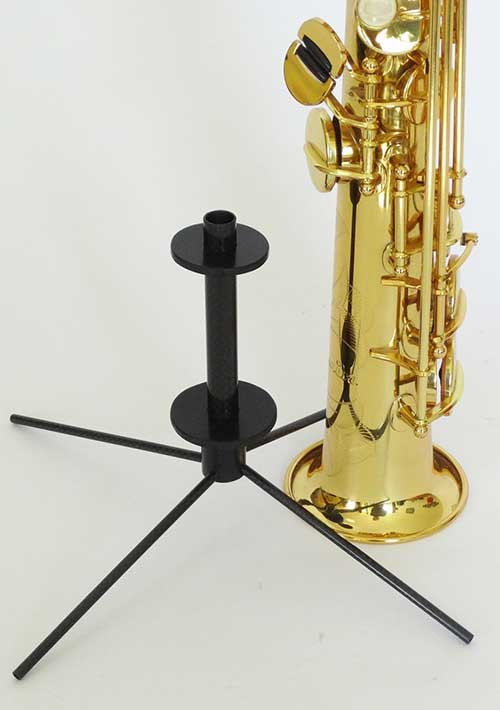
Alto
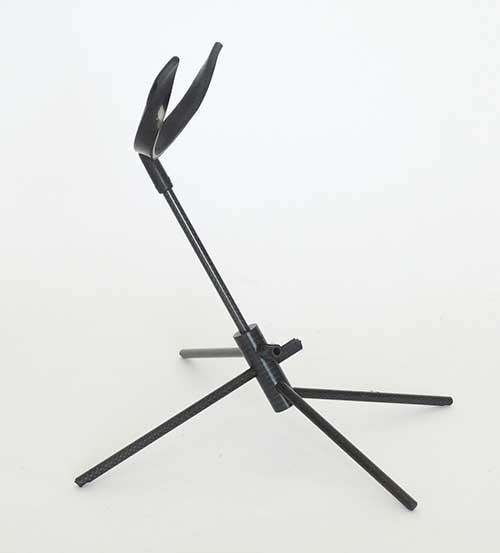
Tenor
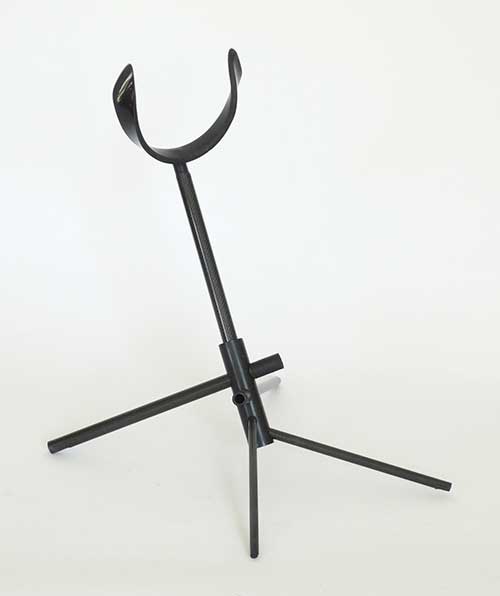
Baritone
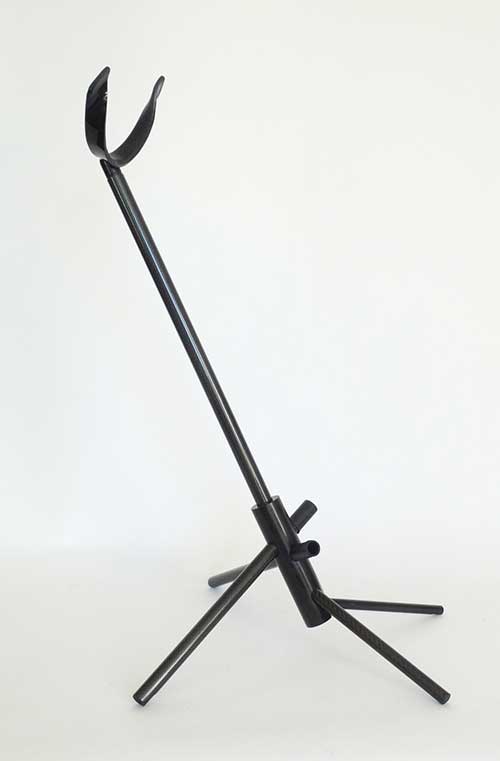






September 1, 2018 @ 11:09 am
Thanks for the article.Wonder what type of carbon fiber stand needs my curved soprano sax ! Would you kindly tell me the prices and how can I get them .Probably I needs 2 ‘cos I have a straight soprano sax too.Any chance to get them at retail price here in London ?Many Thanks
Napo Camassa.
September 1, 2018 @ 8:22 pm
How Much are they, sop alto,tenor?
September 3, 2018 @ 1:52 am
Hi Clifton, thanks for being interested. The tenor and alto are €140, the soprano is €50 ex VAT ex shipment. there is also an alto adaptor which makes the tenor stand quite reliable for alto too. You can find all you need to know here: http://woodwinddesign.eu/index.php/en/component/virtuemart/products-1/saxophone-stands?Itemid=122
September 3, 2018 @ 1:47 am
Hi Napo, thanks for being interested in my innovative designs. I do not have a curved sop stand yet, few people have asked fo it until now. (Same for bass sax) Is it alright to take you email address for a list of potential curved sop clients? I am planning on making one, but there are also so many requests for other stands, and now I am working on flute stands (piccolo>>contrabass) and some brass stands (trombone, trumpet, flugelhorn, french horn). I hope you understand that I am a one person business, so I’m trying. It would help though if you could find more curved soprano players to be interested, so spreading the word could help.
Just Flutes in London have some of my stands for saxes, and I just might be attending the CASSGB single reed day in Nottingham myself.
September 1, 2018 @ 8:55 pm
Also interested in a stand for curved soprano.
September 3, 2018 @ 1:48 am
Hello Doc,
See the above reply.
December 21, 2021 @ 9:25 pm
Is there a US distributer?
September 2, 2018 @ 2:40 am
I’ve been using his carbon fibre stand for bass clarinet for the last year or so. I love it. It’s remarkably stable considering its weight. I don’t think it would withstand a direct push/hit though I’m not sure if the Hercules stand would either.
The major plus is the lightness. A feather would be heavier. (Just a little exaggeration.)
September 3, 2018 @ 1:56 am
Hi Bob, How are you doing. Glad the bass clarinet stand is to your satisfaction. And indeed would any bass clarinet stand withstand a direct and aimed attack? One should never leave the instrument unattended in my opinion, because there’s always clumsy people stubling around, and no transportable stand can be 100% fool proof.
October 24, 2018 @ 11:24 am
I use a folding Hamilton stand for alto/tenor for years. It has holes for clarinet and flute pegs. I spent $32.00 for it. Ya know what? It works.
June 18, 2019 @ 10:02 pm
The most basic question is whether to use a stand at all. Using a stand, albeit one of those tubular steel high center-of-gravity cheapies with the foam rubber bell cradle, anywhere outside the home always made me nervous. I started to sniff around for a good lightweight, compact, secure stand while my interim solution was to detach the neck and put the instrument in its case with the lid ajar. Then it struck me that no stand would offer the protection of the case, where it can’t fall. Maybe doublers needing all their instruments in a quick-draw position benefit from a stand, but I don’t.